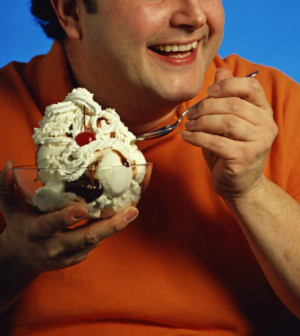- Navigating Your Midlife Crisis: Embracing New Possibilities
- City Raccoons Showing Signs of Domestication
- Mapping the Exposome: Science Broadens Focus to Environmental Disease Triggers
- One Week Less on Social Media Linked to Better Mental Health
- Your Brain Changes in Stages as You Age, Study Finds
- Some Suicide Victims Show No Typical Warning Signs, Study Finds
- ByHeart Formula Faces Lawsuits After Babies Sickened With Botulism
- Switch to Vegan Diet Could Cut Your Greenhouse Gas Emissions in Half
- Regular Bedtime Does Wonders for Blood Pressure
- Dining Alone Could Mean Worse Nutrition for Seniors
Type 1 Diabetes Lowered Survival in Study


People with type 1 diabetes faced a much higher risk of dying over the course of a 14-year study than people without the disease, Swedish researchers report.
The good news was that the closer someone with type 1 diabetes got to their blood sugar goals (glycemic control), the lower the risk of dying. The bad news was that even those with the best blood sugar management still had roughly double the risk of dying from any cause or a heart disease-related cause.
“What our study shows, which is important to emphasize, is that glycemic control seems to be really crucial for prognosis. For those with very poor glycemic control, the risks of dying were eight to 10 times increased,” said study author Dr. Marcus Lind, an associate professor at the University of Gothenberg and chief physician of diabetology at Uddevalla Hospital in Sweden.
The risk of dying during the study was dramatically higher — 30 to 40 times higher — for people with severe kidney disease, according to Lind. One bright spot in the report was that the researchers found no increased risk of dying from cancer for people with type 1 diabetes.
Lind and his colleagues reported their findings in the Nov. 20 issue of the New England Journal of Medicine.
Type 1 diabetes is an autoimmune condition that causes the destruction of the insulin-producing cells in the pancreas, leaving people unable to produce insulin, according to JDRF (formerly the Juvenile Diabetes Research Foundation). Insulin is a hormone that’s crucial for moving sugar out of the blood and into cells for fuel. That means people with type 1 diabetes must figure out how much insulin they need every time they eat, and then inject insulin with a needle, or use an insulin pump to deliver insulin through a small tube that needs to be re-inserted underneath the skin every few days.
In the current study, Lind and his colleagues followed nearly 34,000 people with type 1 diabetes from 1998 through 2011. The researchers compared each person to five people who were matched for age, sex and county of residence.
The average age of those included in the study was nearly 36. Forty-five percent were women. The average duration of type 1 diabetes was 20 years, according to the study.
During the study follow-up, 8 percent of those with diabetes died compared to 3 percent of those without the disease.
Men — both with diabetes and without — were more likely to die during the study period. And, the older someone was — again with diabetes or without — the more likely they were to die during the study period.
But, for every gender and for every age, people with type 1 diabetes were significantly more likely to die of a heart disease-related cause or any cause than people without diabetes, the investigators found.
The differences really became obvious, however, when the researchers broke the data down by blood sugar management. They looked at a measurement called hemoglobin A1C (HbA1C), which gives a rough estimate of a person’s blood sugar levels over the past two to three months, according to the American Diabetes Association (ADA).
For many people with type 1 diabetes, the ADA’s target goal is an HbA1C under 7 percent. People with type 1 diabetes with an HbA1C of 6.9 percent or less had twice the risk of dying from any cause during the study, and a three times higher risk of dying from heart disease-related causes.
If HbA1C jumped to 9.7 percent or higher, the risk of dying from any cause was 8.5 times higher for people with type 1 diabetes compared to people without the disease. And, the risk of death from a cardiovascular cause was nearly 10.5 times higher for people with diabetes, the researchers found.
Lind said the researchers don’t know exactly why the risk of death is consistently higher for people with type 1 diabetes. He said one theory is that people who are currently meeting their blood sugar goals may not have managed their blood sugar levels as well in the past, and higher blood sugar levels in the past may contribute to cardiovascular disease risk.
He also noted that even when people meet their blood sugar goals, they still may have many periods of time when their blood sugar levels are high.
“Even people with good glycemic control can have swings in glycemia. They can have periods of highs and lows, and those swings may contribute to tissue damage,” suggested Helen Nickerson, director of translation development for JDRF.
“Managing type 1 diabetes is incredibly challenging, even for those who are really on the ball. This study’s findings that people with even reasonably good control still had twice as much risk of death are disturbing,” she said.
“We need to find ways to make it easier for people with type 1 diabetes to improve glycemic control without risking [low blood sugar levels],” said Nickerson, who added that devices such as the artificial pancreas will likely help with that goal.
Lind agreed that good blood sugar management is key, especially in those younger than 30 or 40. He said a major risk of death in younger people with type 1 diabetes is a condition called diabetic ketoacidosis (DKA), which occurs when blood sugar levels are persistently very high. DKA — the symptoms of which include vomiting, dehydration, gasping, confusion and even coma — can be deadly.
But, he acknowledged that bringing blood sugar levels down can be difficult because very low blood sugar levels are also dangerous. Newer technologies such as insulin pumps and continuous glucose monitors can help people with type 1 diabetes try to strike that balance. Lind recommended talking to your doctor or diabetes educator if you’re having trouble managing your blood sugar levels.
More information
Learn more about type 1 diabetes from JDRF.
Source: HealthDay
Copyright © 2025 HealthDay. All rights reserved.










